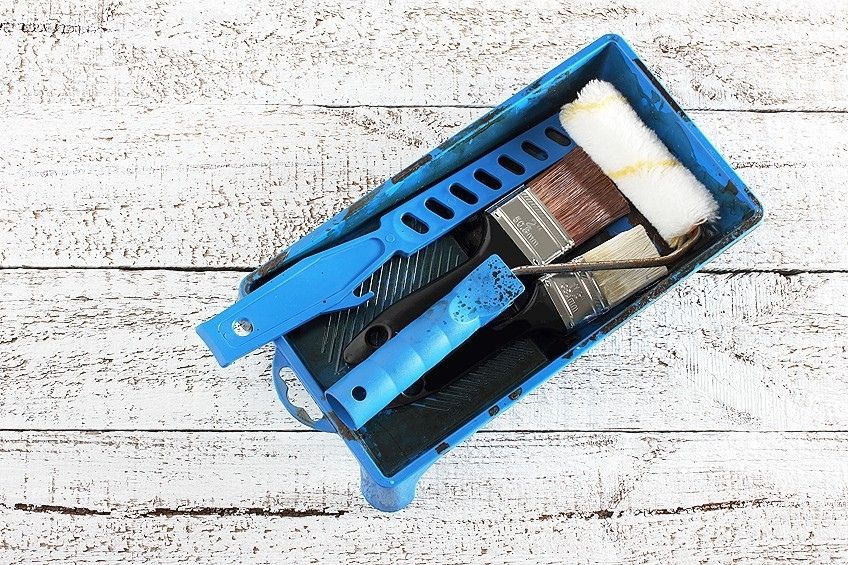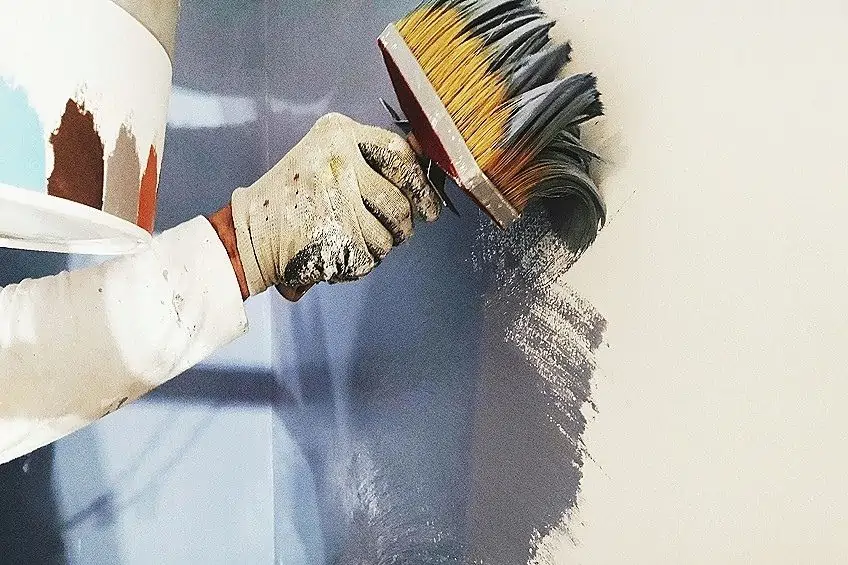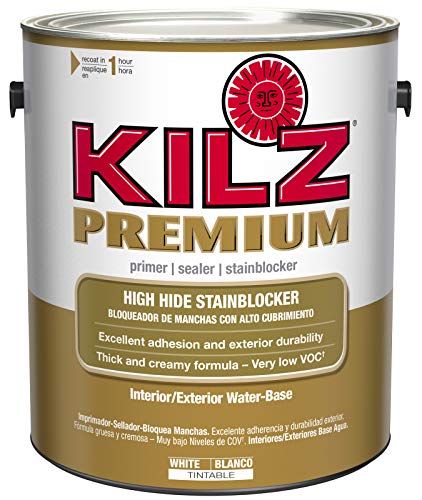Latex Paint Over Oil Based Primer – Everything You Need to Know
This post may contain affiliate links. We may earn a small commission from purchases made through them, at no additional cost to you.
What is latex paint? Latex is just another word used for vinyl styrene paint or water-based acrylic paint. The reason latex is used for these types of paints is because they all possess chains of artificial polymers that perform similar to actual natural latex. Another term used when referring to latex paint is Acrylic. You may ask, can I use latex paint over oil-based primer? Read further and discover how to do this and create a perfect result.
Can You Use Latex Paint Over Oil Based Primer
Yes, you can use latex paint over oil primer, but you cannot apply an oil-based paint over latex. For the latex paint over oil primer to be successful, you need to first ensure that your painted surface is properly dry. This is your best option, as there are no inherent characteristics of completely dry oil-based paint that will prevent a layer of latex paint from adhering to it.
In water-based paints, the binding agent used to combine coating with pigment is water. On the other hand, in oil-based paint, this binding agent is oil. When using oil-based paint you will notice it has a strong smell and has an oily feeling, but after a few days, that will all evaporate. So, when the paint has fully dried, there is no more oil present on the surface and the smell would have also disappeared.
As with all painting jobs, surface preparation is important. This means that you will have to key the surface by sanding it down, cleaning it, and then cleaning it again using a damp clean cloth. Make sure you use a primer coat before you paint with the latex paint.
Not all surfaces need to be primed, but for this paint job, it is essential. Remember, that any gloss finish painted surface does not easily take a second coat of another painting. So, if you intend to apply numerous layers of oil-based paints, it would be advisable to scrape off any paint first.

Latex Paint Explained
In the past, the formula for this paint was classified as ‘Latex’. This is because they were originally products of rubber, which existed in various forms. These rubber products make up the resin element of the paint. Over the years this rubber base was slowly replaced with water-based elements. Today, these paints are suitable for all types of painting jobs like walls, ceilings, kitchen tables, and much more. Here are the main varieties of Latex Paint:
- Vinyl Acrylic
- Alkyd Modified Latex
- 100% Latex Acrylic
Out of these, the 100% latex acrylic has proved to be the best of the three because it binds extremely well to surface material and also keeps excellent color.
Vinyl acrylic paint is cheaper than all the others and is preferred for indoor applications, particularly on walls. Lastly, the alkyd modified latex is found to be excellent when applied on exterior surfaces and holds up well against varied weather conditions.
- Offers excellent coverage and color quality
- Very strong adhesion and durability
- Suitable for indoor/outdoor use with rust protection
Oil Primer for Latex Paint Explained
A primer is a special paint product that functions as a base coating before the finish coat is applied. The purpose of a primer as a foundation paint is that they adhere perfectly to the surface and their formulation gives a uniform, and smooth quality. Due to their excellent adhesion characteristic, this formulation can guarantee the finished coat will not flake or peel after it has been applied.
There are several different types of primers on the market, but oil-based primers appear to be the most popular. They are used by painters as well as woodworkers because they have proven to be effective and reliable over the years.
- Weather and corrosion-resistant primer
- Oil-based formula for a durable protective coating
- Creates a flat white finish for all kinds of topcoats
The oil-based primers have proven to be reliable on outdoor as well as indoor surfaces. Before you apply the oil primer latex paint, you first need to make sure the surface is clear with no prior coating.

How to Paint Latex Over Oil-Based Primer
Can you use latex paint over oil-based primer? When doing this, it does not have anything to do with the base layer being oil-based, but more that it is merely one paint job over another. We all understand that oil-based paints give a glossy finish, so the main issue here is to concentrate on the gloss finish and not so much on the contents of the undercoat.
No matter what type of paint you may use, you will never have the same adhesion to your surface as when you apply your paint over a primed area. Bear in mind that a lot of the work involved is in the preparation, since once you have properly prepared the surface, it is easy to apply the paint to that surface. Now you know the answer to the question of whether you can use latex paint over oil-based primer.
Remove Any Old Gloss Paint
Using fine-grit sandpaper, remove all old oil-based paint from the surface. This will provide for better paint adhesion. It is esential that you ensure that all of the shine or gloss has been removed, as a smooth finish is as effective as dirt in preventing a finish coat from sticking properly. If there are any loose pieces of paint on the surface remove it with a putty knife or similar tool. Now that the surface is clean, fill any holes or gaps by using wood filler or wood putty.
Remove Any Debris
If there is any old debris left on the surface, this will have a detrimental effect on the latex sticking properly to the surface. Some projects will allow you to apply latex over latex without thorough cleaning. However, this project is not one of them, as you need to do a deep clean of the surface.
You will need to use TSP Heavy Duty cleaner, which you can add to a bucket of water to make sure all debris is removed. This product is available in most home improvement and hardware stores. Simply mix in warm water and apply with a clean cloth. Apply the paint only after the surface has dried out fully.
Clean the Surface With a Clean Cloth
Once the surface has completely dried out, use a tack or any cotton cloth to wipe the surface down. A tack cloth is a cheesecloth that has been impregnated with beeswax and is inexpensive. The sticky surface of the cloth is ideal for lifting off any loose dirt that may still be on the surface. When rubbing with the cloth do not apply too hard pressure, as this will result in the wax coming off the cloth and depositing onto the surface. If this happens, it is then exceedingly difficult to remove the loose dirt.
Now You are Ready to Paint
Now that the surface is thoroughly clean and dry, you can begin to paint. Do not use excessive amounts of paint on the brush. Begin painting slowly with even strokes, constantly maintaining a wet edge. When painting, use only a high-quality paintbrush to ensure the best results. You can give the surface a second coat after two hours.

What Surfaces are Coated with Oil-Based Paints
In the USA, oil-based paints have almost been completely phased-out since 2005. So, we may then ask the question, what then has latex paint over oil primer got to do with us in 2020? If you have bought an old house, or if you are still living in an old house, then your house certainly will have oil-based paints as latex paints were only instituted in the 1940s.
Even if your house is fairly new, there may be areas where oil-based paints were used seeing that they were not banned. You are still able to buy oil-based paints today, but in smaller quantities. Many professional painters still prefer oil-based paint, as it gives a much smoother and harder finish. Here again, is the answer to whether you can paint latex over oil primer.
How can you determine whether any surfaces in your home have been painted with oil-based paints? A sniff-test won’t work, as once the paint has been on a surface for a length of time, it no longer feels or smells like an oil-based paint. One way of telling is the surface quality: oil-based paints have the property of self-leveling. Once you have applied the paint, it flattens and levels by itself and leaves no gaps, holes, bubbles, or brush marks. Window and door frames painted with oil-based paint will have a hard and smooth glass-like finish. So, what types of structures or areas require a smooth, durable finish coating?
- Baseboards
- Window trims
- Door casings
- Fireplace mantels
- Crown moldings
- Shelves
- Kitchen cabinets
Types of Primers
All primers are characterized in terms of their main components. A primer is a compound consisting of various substances such as shellac, water, and oil which form the basis of paint. Let us now consider a few of the more common types of primers used.

Latex Primers
If you are looking to get your drywall ready for a painting project, then Latex Primers are your best choice. Latex Primers are fast drying and usually dry fast by 3 to 4 hours. They are different from oil-based paints, as they appear much less brittle and provide you with an exceptional finish on surfaces that are hard to paint like pinewood. Not only is it good to use on wood, but it can also give you a great finish on brick, galvanized metals, and concrete surfaces.
If your walls or surfaces have been marked or stained by smoke, pens, or crayons, latex primer does an excellent job of blocking out those marks. Although it is fairly effective for this, it is still not as good as oil-based or shellac-based primers for blocking out stains.
Latex primers are water-based, and as such, they include low or no levels of volatile organic substances, which makes them excellent for the environment. Another advantage of this type of primer is they are easy to clean up and only requires water and a little soap to make an end to any nasty spills.
Latex primers are also much cheaper and will resist peeling, flaking, yellowing, and much more. However, when it comes to painting various types of wood that are found in damp areas, we recommend that you use acrylic primers instead.
- Powerful stain-blocking water-based formula
- The perfect consistency for a smooth and level finish
- Excellent adhesion for most surfaces
Oil-Based Primers
Oil-based primers have been on the market for decades. They are extremely popular and work great with latex or oil paints. These primers are also very versatile and can be used on metals, wood, on surfaces that have been painted or unpainted, and is also an ideal primer for exterior or interior walls.
Most oil-based primers are excellent for covering up stains and prevent them from showing after you have applied the new topcoat of paint. Stains blocked by this type of paint include nicotine, water, and ink. The oil-based primers are excellent when applied to bare wood, as the properties of the formula allow the primer to seal off the porous surfaces of the material easily. When used on certain types of wood, such as cedar and redwood, it stops the wood from releasing tannins that are harmful to the environment.
One major disadvantages of oil-based primer is its drying time, as it takes a long time to cure completely. Most oil-based primers take around 24 hours to dry and during this time it releases toxic (VOC) fumes that are harmful to plants, pets, and, of course when inhaled over long periods, to humans. In addition, when cleaning your applicators and brushes you will need to use solvents or thinners that also emit toxic fumes.
If using an oil-based primer, it is not recommended for any masonry surfaces. A great benefit of using an oil-based primer is that once it has dried properly, you are left with a durable and smooth finished surface.
- A white spray primer for easy coverage
- Strongly adheres to various surfaces for a durable undercoat
- Suitable for interior and exterior use
Shellac Primers
Shellac primers have been used for hundreds of years and are said to be the best primers when used to seal off stains caused by rust, smoke, or water damage.
Similar to water-based primers, these primers are excellent when used to seal wood surfaces and stop bleeding and tannins from escaping. They have an elastic property that makes them an excellent choice for use on plastic, metals, or plaster surfaces.
A major advantage of using shellac primers is that they are extremely fast drying and can be dry within an hour. Therefore, they are perfect for use on projects that need to be completed in a short time. When it comes to cleaning up you will need to use denatured alcohol.
- A white spray primer for easy coverage
- Strongly adheres to various surfaces for a durable undercoat
- Suitable for interior and exterior use
Safety Precautions
As many primers and paints emit toxic fumes when applied, they can be hazardous to one’s health over long periods of exposure. Always be careful and work outside or in a well-ventilated space allowing the air to circulate. We also recommend that you wear protective equipment like masks, gloves, and goggles.
Can you paint latex over oil primer? Yes. If you are going to paint a lighter color over a darker color, it is always advisable to prime the surface. A coat of primer is always a necessity when you paint with semi-gloss or eggshell paints, as they tend to leave an uneven finish if not primed.
If you have walls that only need minor repairs, then you can prime only the spots or areas where the damage is found. If you have walls that need to be patch plastered, we recommend you use True EasyCare Ultra-Premium Interior Primer/Sealer.
Using latex paint can provide amazing results through a unique finish. When using this paint, it is important to understand the priming process, and how it can be used over an oil-based primer. Happy painting!












